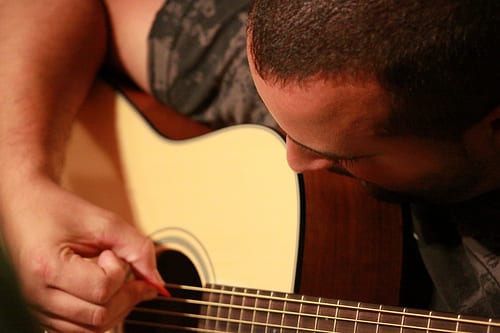 Learning the guitar is a great goal in itself – but you’ll need to get more specific if you want to truly make some progress! Read on as Hillsboro, OR guitar teacher Geoff A. walks you through the goal-setting process…
Learning the guitar is a great goal in itself – but you’ll need to get more specific if you want to truly make some progress! Read on as Hillsboro, OR guitar teacher Geoff A. walks you through the goal-setting process…
For Beginners
The first goal is getting the fingers of the fretting hand to cooperate in forming chords. I begin with E, A, G, C, B7, and D chords. Practice ten to fifteen minutes twice a day and understand: your fingers will hurt a few weeks until calluses form, depending on how much you practice.
The second goal is learning to string chords together with smooth transitions, in time to a beat. This takes practice and time. Practicing with a metronome is essential for beginner. Set the metronome to around 54 beats per minute and strum once per beat, four beats per chord, then switch to the next chord. At first there will be beat clicks between chord changes – but always play in time with the metronome. The “game” is to remove clicks between chords one by one, until there are no clicks between changes.
You should also give yourself permission to not do well at first. Allow yourself the time necessary to understanding what you are learning. Your progress may be slower than others, but try not to compare yourself too much. I have worked with students who learned quickly, then struggled with improving. Others have struggled at first, then made amazing progress afterward.
For Intermediate Players
It is important to discover what you lack. You might know you struggle with things, like good time-keeping and chord knowledge. And you know nothing about other things.
You need improved chord knowledge – not just learning new chords, but learning how chords are put together, which requires knowing your scales. Limitations in chord knowledge undermines long-term enjoyment, so brush up on your theory.
For Advanced Players
At this stage, musicians often need a reality check. Many believe they are more “advanced” than they are. Once you accept this truth, then you are ready to do the necessary work to improve.
This generally includes similar things to intermediate players’ needs, which is to find where the holes in your knowledge lie. Once determined, a plan must be created to overcome obstacles and meet challenges to make the strides toward advanced abilities.
Bottom Line
This article covers a very limited view of goal-setting for each level, based on my 25 years of teaching experience. At the end of the day, it is about embracing life-long learning and growing in your pursuit of musical excellence, whether for fun or for career aspirations. You have to be open to the unknown, the “undiscovered country,” with a good teacher giving you the guidance you need.
The right teacher will help you down that road, as long as you understand the journey may be longer, and more difficult, than you imagined. As they say, the journey isn’t exciting if it doesn’t scare you a little. The reward is that playing music will deliver dividends far beyond the technical knowledge you learn. And that is a journey worth taking!
 Geoff A. teaches songwriting, music theory, bass guitar, and guitar lessons in Hillsboro, OR. His specialties include rock, blues, Americana, pop, alternative, folk, finger style, bluegrass, worship & CCM, gospel, and jazz styles. Geoff joined the TakeLessons team in February 2013. Learn more about Geoff here!
Geoff A. teaches songwriting, music theory, bass guitar, and guitar lessons in Hillsboro, OR. His specialties include rock, blues, Americana, pop, alternative, folk, finger style, bluegrass, worship & CCM, gospel, and jazz styles. Geoff joined the TakeLessons team in February 2013. Learn more about Geoff here!
Photo by Eryne Donahue
Suzy S.
